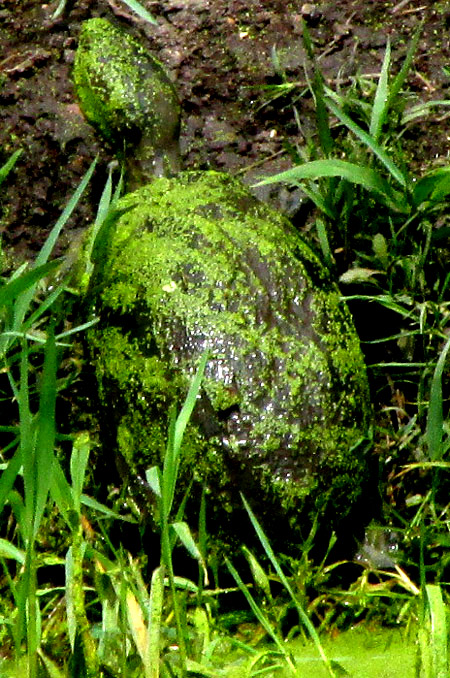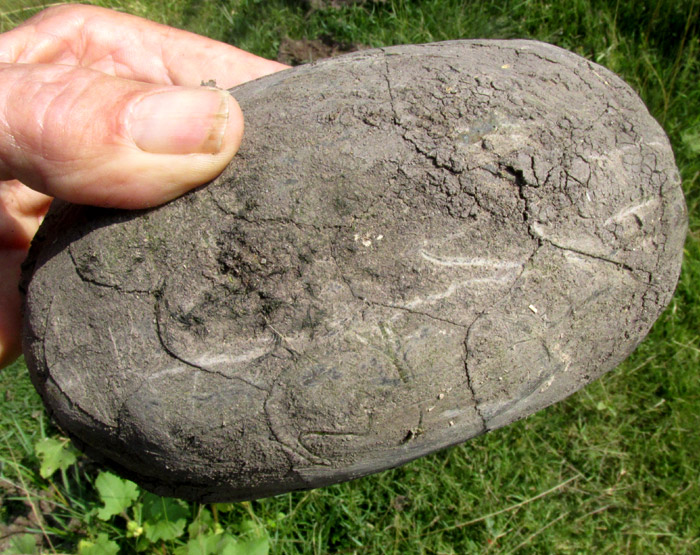Excerpts from Jim Conrad's
Naturalist Newsletter
Entry dated September 18, 2023, issued from near Tequisquiapan, semiarid scrub, elevation about 1,900m (6200 ft), Querétaro state, MÉXICO
(~N20.57°, ~W99.89°)
But now a mud turtle has turned up about a kilometer from the above pond, the only remaining body of water in the general area. Apparently the turtle had emerged from drying out mud at the bottom of the town's empty reservoir about 600m away. In mid morning the turtle was heading up a dry gully leading toward the above pond, but with a road and numerous hungry dogs between the turtle and the pond's waters. I gave the turtle a ride, but before releasing it into the pond took the following pictures: The carapace's scute shapes were partly covered with dried mud, but enough could be seen to be helpful. More revealing were the scutes on the under-shell, the plastron: That view alone provides our turtle's identity. In this area two very similar mud turtle species can be found. In our turtle, the largest scutes, the pectorals immediately behind the "bridge" where the front part of the plasteron hinges upward to close against the carapace, is proportionally larger than the other scutes, causing the other scutes to be narrower. To see what I mean, do an image search for a picture of the plasteron of Kinosternon hirtipes, the species which our turtle is not. Ours is KINOSTERNON INTEGRUM, along with the other species known as Mexican Mud Turtle. Our species is described as the most widely distributed mud turtle species in Mexico. Wanting to see colors and patterns on the head, before releasing our turtle into the watermeal she was placed in grass near the water, where I waited half an hour, when her head had incrementally emerged as much as is seen below: Whiteness about the mouth with dark speckles is right for Kinosternon integrum. I read that on females the nostrils are more rounded and brownish than on males, who display yellow nostrils. Our turtle looks like a brown-nosed female. Kinosternon integrum is endemic just to Mexico, where it's found nearly throughout in shallow ponds, lakes, rivers,and moist areas in general, except for the Yucatan Peninsula. The species is omnivorous, feeding on everything from algae and grass seeds to ants and bees. In Mexico the species, despite its wide distribution, is considered "subject to protection," because of its vulnerability to the pollution and wetland destruction so common throughout Mexico. In the 2023 study by Christian Berriozabal-Islas and others entitled "Ni conocidas, ni carismáticas: estado de conservación de las tortugas del género Kinosternon (Spix, 1824) (Testudines: Kinosternidae) y sus factores de amenaza," a population of Kinosternon integrum in a reservoir is singled out as having been particularly destroyed by pollution from a brick manufacturer in the state of Guanajuato. Possibly because of stress caused by pollution and habitat destruction, remaining turtles tend to be vulnerable to disease organisms. The 2010 study by Sylvia Páz Díaz and others entitled "Infection status of the estuarine turtles Kinosternon integrum and Trachemys scripta with Gnathostoma binucleatum in Sinaloa, Mexico" found 80.0% of the Kinosternon integrum turtles examined parasitized by Gnathostoma species, which are a kind of nematode that can be spread to humans who eat the animal's flesh raw or poorly prepared.
MEXICAN MUD TURTLE
 At a little pond kept filled with water despite Mexico's ongoing long-term drought -- thanks to negligent big landowners letting irrigated fields overflow -- for months I've been taking pictures such as the one at the right. However, as seen there, always the turtle had emerged so heavily covered by watermeal that the shapes of the shell's plates, or scutes, and patterns and colors on the head were obscured. Scute shapes are important for turtle identification to the species level. This turtle's high top shell, or carapace, and narrowly oblong shape suggested a kind of mud turtle, genus Kinosternon, but in this part of upland central Mexico more than one mud turtle species are found, and they're very similar. I just couldn't identify that turtle through all the watermeal.
At a little pond kept filled with water despite Mexico's ongoing long-term drought -- thanks to negligent big landowners letting irrigated fields overflow -- for months I've been taking pictures such as the one at the right. However, as seen there, always the turtle had emerged so heavily covered by watermeal that the shapes of the shell's plates, or scutes, and patterns and colors on the head were obscured. Scute shapes are important for turtle identification to the species level. This turtle's high top shell, or carapace, and narrowly oblong shape suggested a kind of mud turtle, genus Kinosternon, but in this part of upland central Mexico more than one mud turtle species are found, and they're very similar. I just couldn't identify that turtle through all the watermeal.

